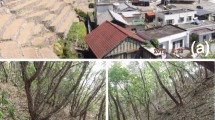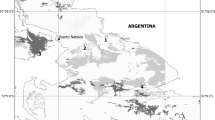Abstract
Throughout Pinus ponderosa–Pseudotsuga menziesii forests of the southern Colorado Front Range, USA, intense logging and domestic grazing began at the time of Euro-American settlement in the late 1800s and continued until the early 1900s. We investigated the long-term impacts of these settlement-era activities on understory plant communities by comparing understory composition at a historically logged and grazed site to that of an environmentally similar site which was protected from past use. We found that species richness and cover within functional groups rarely differed between sites in either upland or riparian areas. Multivariate analyses revealed little difference in species composition between sites on uplands, though compositional differences were apparent in riparian zones. Our findings suggest that settlement-era logging and grazing have had only minor long-term impacts on understories of upland Front Range P. ponderosa–P. menziesii forests, though they have had a greater long-term influence on riparian understories, where these activities were likely the most intense.



Similar content being viewed by others
References
Anderson RS, Betancourt JL, Mead JI, Hevly RH, Adam DP (2000) Middle- and late-Wisconsin paleobotanic and paleoclimatic records from the southern Colorado Plateau, USA. Palaeogeogr Palaeocl 155:31–57. doi:10.1016/S0031-0182(99)00093-0
Bakker JD, Moore MM (2007) Controls on vegetation structure in southwestern ponderosa pine forests, 1941 and 2004. Ecology 88:2305–2319. doi:10.1890/06-1775.1
Belsky AJ, Blumenthal DM (1997) Effects of livestock grazing on stand dynamics and soils in upland forests of the interior west. Conserv Biol 11:315–327. doi:10.1046/j.1523-1739.1997.95405.x
Brown PM, Cook B (2006) Early settlement forest structure in Black Hills ponderosa pine forests. For Ecol Manag 223:84–290
Brown PM, Kaufmann MR, Shepperd WD (1999) Long-term, landscape patterns of past fire events in a montane ponderosa pine forest of central Colorado. Landsc Ecol 14:513–532. doi:10.1023/A:1008137005355
Cooper CF (1960) Changes in vegetation, structure, and growth of southwestern pine forests since white settlement. Ecol Monogr 30:129–164. doi:10.2307/1948549
DeLay TJ (1989) The history of the South Platte Ranger District. Unpublished report on file at US Department of Agriculture, Forest Service, Pike National Forest, South Platte Ranger District, Morrison, CO
Dillon GK, Knight DH, Meyer CB (2005) Historic range of variability for upland vegetation in the Medicine Bow National Forest, Wyoming. Gen Tech Rep GTR-RM-139. US Department of Agriculture, Forest Service, Rocky Mountain Forest and Range Experiment Station, Fort Collins, CO
Fornwalt PJ, Kaufmann MR, Huckaby LS, Stoker JM, Stohlgren TJ (2003) Non-native plant invasions in managed and protected ponderosa pine/Douglas-fir forests of the Colorado Front Range. For Ecol Manag 177:515–527
Fulé PZ, Covington WW, Moore MM (1997) Determining reference conditions for ecosystem management of southwestern ponderosa pine forests. Ecol Appl 7:895–908. doi:10.1890/1051-0761(1997)007[0895:DRCFEM]2.0.CO;2
Gary HL, Currie PO (1977) The Front Range pine type: a 40-year photographic record of plant recovery on an abused watershed. Gen Tech Rep GTR-RM-46. US Department of Agriculture, Forest Service, Rocky Mountain Forest and Range Experiment Station, Fort Collins, CO
Gildar CN, Fulé PZ, Covington WW (2004) Plant community variability in ponderosa pine forest has implications for reference conditions. Nat Areas J 24:101–111
Jack JG (1900) Pikes Peak, Plum Creek, and South Platte Reserves. Part V, forest reserves. 20th annual report, US Geological Survey, 1898–99. Government Printing Office, Washington DC, pp 39–115
Kaufmann MR, Regan CM, Brown PM (2000) Heterogeneity in ponderosa pine/Douglas-fir forests: age and size structure in unlogged and logged landscapes of central Colorado. Can J For Res 30:698–711. doi:10.1139/cjfr-30-5-698
Kaufmann MR, Fornwalt PJ, Huckaby LS, Stoker JM (2001) Cheesman Lake—a historical ponderosa pine landscape guiding restoration in the South Platte Watershed of the Colorado Front Range. In: Vance RK, Covington WW, Edminster CB (eds) Ponderosa pine ecosystems restoration and conservation: steps toward stewardship. Proceedings of RMRS-P-22. US Department of Agriculture, Forest Service, Rocky Mountain Research Station, Fort Collins, CO, pp 9–18
Keeling EG, Sala A, DeLuca TH (2006) Effects of fire exclusion on forest structure and composition in unlogged ponderosa pine/Douglas-fir forests. For Ecol Manag 237:418–428
Kerns BK, Moore MM, Timpson ME, Hart SC (2003) Soil properties associated with vegetation patches in a Pinus ponderosa bunchgrass mosaic. West N Am Nat 63:452–462
Leiberg JB, Rixon TF, Dodwell A (1904) Forest conditions in the San Francisco Mountains Forest Reserve, Arizona. U.S. Geological Survey Professional Paper No. 22. Government Printing Office, Washington, DC
Madany MH, West NE (1983) Livestock grazing—fire regime interactions within montane forests of Zion National Park, Utah. Ecology 64:661–667. doi:10.2307/1937186
McCune B, Grace JB (2002) Analysis of ecological communities. MjM Software Design, Gleneden Beach, OR
Mielke PW, Berry KJ (2001) Permutation methods: a distance function approach. Springer, New York, NY
Powell DC (1987) Field guide to forest plants of south-central Colorado. R2-ECOL-87-01. US Department of Agriculture, Forest Service, Rocky Mountain Region
Riddle MJ, Kane AE (1991) A cultural resources survey of the Little Turkey Creek prescribed fire project. Unpublished report on file at US Department of Agriculture, Forest Service, Pike and San Isabel National Forests, Pueblo, CO
Schneider EC (1911) The succession of plant life on the gravel slides in the vicinity of Pike’s Peak. Colo Coll Publ Sci Ser 12:289–311
Smith DR (1967) Effects of cattle grazing on a ponderosa pine-bunchgrass range in Colorado. Tech Bull 1371. US Department of Agriculture, Washington, DC
Stohlgren TJ, Falkner MB, Schell LD (1995) A modified-Whittaker nested vegetation sampling method. Vegetatio 117:113–121. doi:10.1007/BF00045503
Swetnam TW, Allen CD, Betancourt JL (1999) Applied historical ecology: using the past to manage for the future. Ecol Appl 9:1189–1206. doi:10.1890/1051-0761(1999)009[1189:AHEUTP]2.0.CO;2
USDA (2007) The PLANTS database. National Plant Data Center, Baton Rouge, LA. http://www.plants.usda.gov
USDA Forest Service (1992) Soil survey of Pike National Forest, eastern part, Colorado. US Department of Agriculture, Forest Service, Rocky Mountain Region and Soil Conservation Service, Lakewood, CO
USDA Forest Service (2007) Fire effects information system. US Department of Agriculture, Forest Service, Rocky Mountain Research Station, Fire Sciences Laboratory, Missoula, MT. http://www.fs.fed.us/database/feis
Veblen TT, Donnegan JA (2005) Historical range of variability assessment for forest vegetation of the National Forests of the Colorado Front Range (USDA Forest Service Agreement No. 11020001-99-0333). US Department of Agriculture, Forest Service, Golden, CO
Vitousek PM, Mooney HA, Lubchenco J, Melillo JM (1997) Human domination of earth’s ecosystems. Science 277:494–499. doi:10.1126/science.277.5325.494
Acknowledgments
We are grateful to the Upper South Platte Watershed Protection and Restoration Project and the Denver Water Board for funding this research. We would like to thank several people for their help on this project. Mandy Cipolat, Chris Cowles, Micky McNaughton, Lisa Schell, and Betsy Smith helped with data collection. Jonathon Coop, John Frank, Rudy King, Monique Rocca, William Romme, and three anonymous reviewers provided guidance with analyses and offered comments on the earlier versions of the manuscript. We would also like to acknowledge Denver Water Board for allowing us to conduct research on their property and in their archives.
Author information
Authors and Affiliations
Corresponding author
Additional information
This article was written and prepared by US Government employees on official time, and therefore it is in the public domain and not subject to copyright.
Rights and permissions
About this article
Cite this article
Fornwalt, P.J., Kaufmann, M.R., Huckaby, L.S. et al. Effects of past logging and grazing on understory plant communities in a montane Colorado forest. Plant Ecol 203, 99–109 (2009). https://doi.org/10.1007/s11258-008-9513-z
Received:
Accepted:
Published:
Issue Date:
DOI: https://doi.org/10.1007/s11258-008-9513-z




